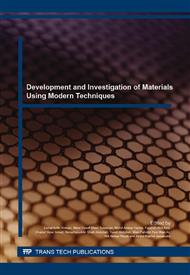p.124
p.131
p.141
p.146
p.151
p.156
p.160
p.165
p.170
Influence of Calcination Temperature on the Microstructure and Crystallographic Properties of Hydroxyapatite from Black Tilapia Fish Scale
Abstract:
Hydroxyapatite extensively used for orthopaedic and dental reconstruction as biomaterials due to their chemical and biological similarity to human hard tissue. Therefore, this paper describes the extraction of natural hydroxyapatite from tilapia fish scale via a conventional heat treatment. The calcination temperatures (600, 800, 1000, and 1200°C) were varied. XRD results indicated that the presences of biphasic phase (HA/β-TCP) were identified during heat treatment. Transformation of biphasic phase to single phase (β-TCP) can be observed at 1200°C, results on decomposition of hydroxyapatite. The degree of crystallinity and crystallite size originated increase with the calcination temperature. The FT-IR spectra confirmed that all organic compounds were eliminated during the heat treatment process. FESEM images were used to determine the size and shape of grains of calcined samples. The biphasic mineral grain size was estimated in range of 500 – 100 nm. The analysis show that variation of calcination temperatures significantly impact on the properties of hydroxyapatite derived from tilapia fish scale.
Info:
Periodical:
Pages:
151-155
Citation:
Online since:
January 2016
Keywords:
Price:
Сopyright:
© 2016 Trans Tech Publications Ltd. All Rights Reserved
Share:
Citation:


